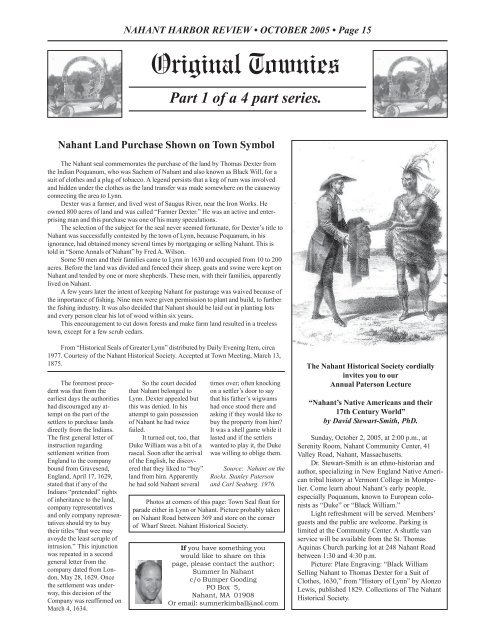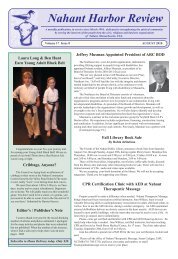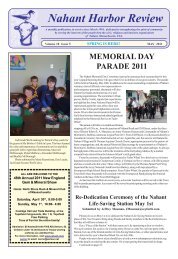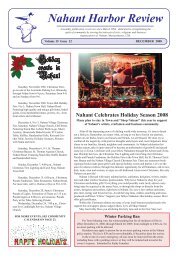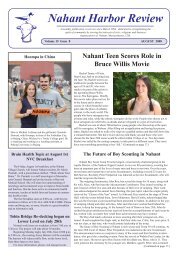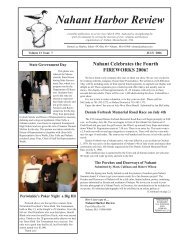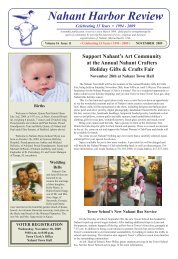OCTOBER 2005.pmd - Nahant, Massachusetts USA
OCTOBER 2005.pmd - Nahant, Massachusetts USA
OCTOBER 2005.pmd - Nahant, Massachusetts USA
Create successful ePaper yourself
Turn your PDF publications into a flip-book with our unique Google optimized e-Paper software.
NAHANT HARBOR REVIEW • <strong>OCTOBER</strong> 2005 • Page 15<br />
Original Townies<br />
Part 1 of a 4 part series.<br />
<strong>Nahant</strong> Land Purchase Shown on Town Symbol<br />
The <strong>Nahant</strong> seal commemorates the purchase of the land by Thomas Dexter from<br />
the Indian Poquanum, who was Sachem of <strong>Nahant</strong> and also known as Black Will, for a<br />
suit of clothes and a plug of tobacco. A legend persists that a keg of rum was involved<br />
and hidden under the clothes as the land transfer was made somewhere on the causeway<br />
connecting the area to Lynn.<br />
Dexter was a farmer, and lived west of Saugus River, near the Iron Works. He<br />
owned 800 acres of land and was called “Farmer Dexter.” He was an active and enterprising<br />
man and this purchase was one of his many speculations.<br />
The selection of the subject for the seal never seemed fortunate, for Dexter’s title to<br />
<strong>Nahant</strong> was successfully contested by the town of Lynn, because Poquanum, in his<br />
ignorance, had obtained money several times by mortgaging or selling <strong>Nahant</strong>. This is<br />
told in “Some Annals of <strong>Nahant</strong>” by Fred A. Wilson.<br />
Some 50 men and their families came to Lynn in 1630 and occupied from 10 to 200<br />
acres. Before the land was divided and fenced their sheep, goats and swine were kept on<br />
<strong>Nahant</strong> and tended by one or more shepherds. These men, with their families, apparently<br />
lived on <strong>Nahant</strong>.<br />
A few years later the intent of keeping <strong>Nahant</strong> for pasturage was waived because of<br />
the importance of fishing. Nine men were given permisision to plant and build, to further<br />
the fishing industry. It was also decided that <strong>Nahant</strong> should be laid out in planting lots<br />
and every person clear his lot of wood within six years.<br />
This encouragement to cut down forests and make farm land resulted in a treeless<br />
town, except for a few scrub cedars.<br />
From “Historical Seals of Greater Lynn” distributed by Daily Evening Item, circa<br />
1977. Courtesy of the <strong>Nahant</strong> Historical Society. Accepted at Town Meeting, March 13,<br />
1875. The <strong>Nahant</strong> Historical Society cordially<br />
The foremost precedent<br />
was that from the<br />
earliest days the authorities<br />
had discouraged any attempt<br />
on the part of the<br />
settlers to purchase lands<br />
directly from the Indians.<br />
The first general letter of<br />
instruction regarding<br />
settlement written from<br />
England to the company<br />
bound from Gravesend,<br />
England, April 17, 1629,<br />
stated that if any of the<br />
Indians “pretended” rights<br />
of inheritance to the land,<br />
company representatives<br />
and only company representatives<br />
should try to buy<br />
their titles “that wee may<br />
avoyde the least scruple of<br />
intrusion.” This injunction<br />
was repeated in a second<br />
general letter from the<br />
company dated from London,<br />
May 28, 1629. Once<br />
the settlement was underway,<br />
this decision of the<br />
Company was reaffirmed on<br />
March 4, 1634.<br />
So the court decided<br />
that <strong>Nahant</strong> belonged to<br />
Lynn. Dexter appealed but<br />
this was denied. In his<br />
attempt to gain possession<br />
of <strong>Nahant</strong> he had twice<br />
failed.<br />
It turned out, too, that<br />
Duke William was a bit of a<br />
rascal. Soon after the arrival<br />
of the English, he discovered<br />
that they liked to “buy”<br />
land from him. Apparently<br />
he had sold <strong>Nahant</strong> several<br />
times over; often knocking<br />
on a settler’s door to say<br />
that his father’s wigwams<br />
had once stood there and<br />
asking if they would like to<br />
buy the property from him?<br />
It was a shell game while it<br />
lasted and if the settlers<br />
wanted to play it, the Duke<br />
was willing to oblige them.<br />
Source: <strong>Nahant</strong> on the<br />
Rocks. Stanley Paterson<br />
and Carl Seaburg. 1976.<br />
Photos at corners of this page: Town Seal float for<br />
parade either in Lynn or <strong>Nahant</strong>. Picture probably taken<br />
on <strong>Nahant</strong> Road between 369 and store on the corner<br />
of Wharf Street. <strong>Nahant</strong> Historical Society.<br />
If you have something you<br />
would like to share on this<br />
page, please contact the author:<br />
Summer In <strong>Nahant</strong><br />
c/o Bumper Gooding<br />
PO Box 5,<br />
<strong>Nahant</strong>, MA 01908<br />
Or email: sumnerkimball@aol.com<br />
invites you to our<br />
Annual Paterson Lecture<br />
“<strong>Nahant</strong>’s Native Americans and their<br />
17th Century World”<br />
by David Stewart-Smith, PhD.<br />
Sunday, October 2, 2005, at 2:00 p.m., at<br />
Serenity Room, <strong>Nahant</strong> Community Center, 41<br />
Valley Road, <strong>Nahant</strong>, <strong>Massachusetts</strong>.<br />
Dr. Stewart-Smith is an ethno-historian and<br />
author, specializing in New England Native American<br />
tribal history at Vermont College in Montpelier.<br />
Come learn about <strong>Nahant</strong>’s early people,<br />
especially Poquanum, known to European colonists<br />
as “Duke” or “Black William.”<br />
Light refreshment will be served. Members’<br />
guests and the public are welcome. Parking is<br />
limited at the Community Center. A shuttle van<br />
service will be available from the St. Thomas<br />
Aquinas Church parking lot at 248 <strong>Nahant</strong> Road<br />
between 1:30 and 4:30 p.m.<br />
Picture: Plate Engraving: “Black William<br />
Selling <strong>Nahant</strong> to Thomas Dexter for a Suit of<br />
Clothes, 1630,” from “History of Lynn” by Alonzo<br />
Lewis, published 1829. Collections of The <strong>Nahant</strong><br />
Historical Society.


